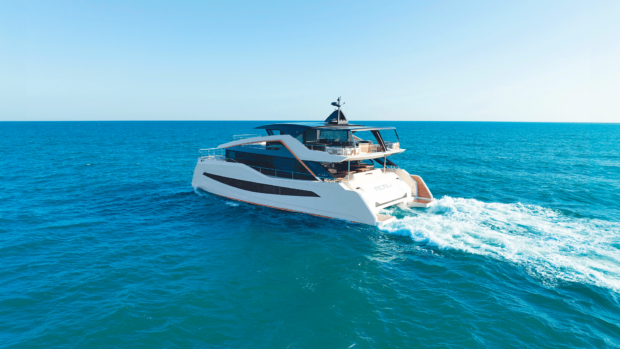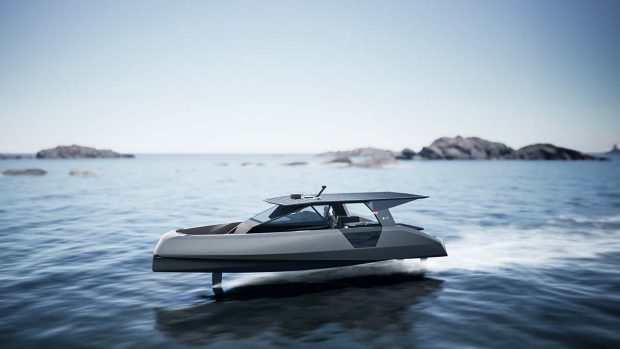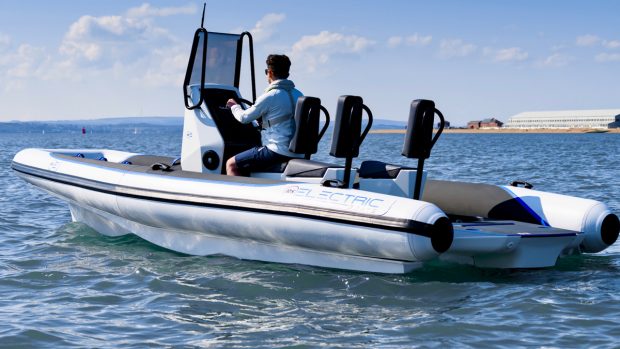This electric or hybrid-engined motorcat takes fuel-efficiency cruising to a new level
Evolution rather than revolution is the name of the established boatbuilder’s game.
The finish and layout of current models might be a quantum leap ahead of where they were a decade ago, but conceptually little has changed. Even new ideas such as Azimut’s Magellano range with its ‘dual-mode’ hull capable of running comfortably at displacement and semi-displacement speeds, offer only tiny gains in fuel efficiency.
But with ever more emphasis on environmental concerns, pressure for change is growing in a motor boat world where 1mpg for a 40ft planing boat is the norm.
Enter Jan van Eck, the man behind the DutchCat. Rather than wait for the mainstream builders to rip up the rule book, he has simply started without one and created what he believes to be the true future of motorboating.

His vision starts with the hull shape. It was seeing catamaran sailing dinghies consistently outperform monohulled ones that convinced Jan twin hulls were more easily driven.
Of course, motorcats are nothing new but most existing powercats are far wider than monohulls of a similar length, making them unwieldy for inland use.
The Fountaine-Pajot 44, for example, has a beam of 6.6m, compared with the monohulled Azimut Magellano 43 at 4.4m. The 41ft DutchCat comes in at 4.9m, far closer to monohull territory and crucially granting it access to the French canal system, where locks are typically just 5.2m wide.
One boat, two versions
Designed by Vripack and RCD Category B-rated, there are two versions of the DutchCat hull.
The ‘Comfort’ version has a round bilge form and long shallow keels, similar to a sailing yacht, and is designed to run at lower speedswith smaller engines.
The ‘Sport’ hull is a more traditional powerboat form with sprayrails and tunnelled props for higher speeds, toppingout at 22 knots with bigger motors.
Crucial though hull design is, it’s only one part of DutchCat’s energy efficiency equation. Similar blue-sky thinking has been brought to bear on pushing that ultra efficient hull shape through the water.
Perhaps the most radical power source is an all-electric setup that uses twin Kräutler 48V 10kW (14hp) or 15kW (21hp) motors connected to conventional shaftdrives for a maximum speed of 8.5 knots and a cruising gait of 4 to 6 knots.
Gel traction 48kWh batteries are standard, with Lithium ones an option.
DutchCat claims about seven hours of cruising at 5 knots and about ten hours to recharge from a 16A supply.
Pure diesel is an alternative. Comfort-spec boats rely on a pair of Yanmar 3YM30 3-cylinder 29hp engines to yield about 11 knots flat out and cruise at 8 knots. Opting for the Sport hull configuration allows twin Yanmar 4BY3 150hp engines to boost maximum velocity toward 22 knots.

Hybrid versions layer on an additional level of efficiency and autonomy. Electric hybrid takes the all-electric drive system and adds a diesel-powered generator, allowing the batteries to be charged while underway. Alternatively, diesel hybrid takes either of the diesel engine options and adds in Kräutler electric motors, positioning them in parallel directly behind the Yanmars, spinning the same shafts.
Out on the water
We had the chance to try the diesel hybrid setup with twin 29hp Yanmars. Two hulls mean two bow thrusters –
a pair of 55Kgf Vetus units combine with wide-spaced shafts to make wriggling out of Amsterdam Marina and on to the IJ fairly painless. Despite being the first boat from this new company, it feels well engineered with commendably low noise levels
at 2,500rpm which equates to a 7-knot cruise. But to really drop the decibels, switching to all-electric is the way to go.
The electric motors use the same engine controls as the diesels, so it’s just a case of switching off the Yanmars, engaging the electric motors and then throttling back up.
Under electric power there are two obvious differences. Performance is muted – 5 to 6 knots is as much as you’ll get if you want meaningful range. But so is noise. The closest comparison would be sailing, with the gentle gurgle of water around
the hulls the only sound.
This speed is more than adequate for inland waterways and should allow for 5.5 hours of cruising from the 38kW battery pack.
Continues below…

Motor boat stabilisers: DMS’s new stabilisation fins
DMS's new flapping fins could become a staple for motor boats

Hybrid heaven: Adler’s 76 Suprema
Taking diesel electric propulsion to a new level, Adler's 76 Suprema may just be too innovative for the yachting marketplace
So how does that efficiency translate to cost? Like any boat, travelling at displacement speeds is the key to the biggest savings – DutchCat hasn’t rewritten the laws of physics. Nonetheless, with the smaller diesel engines, the boat is burning under a gallon an hour at 7 knots, which is less than half that of the slightly longer but narrower hybrid-hulled Magellano 43 (albeit without its 22-knot top end). With marine diesel currently hovering at around £1/litre that’s about £4/hour. At 5 knots under electric power, it’s using roughly 5.5kWh. With 1kWh of mains electric costing 13.5p, that’s about 75p/hour or a miserly 15p per mile!
So is this the future? Well, it’s certainly one of the most credible attempts to create something truly new and efficient that we’ve seen for some time, and it’s telling that it comes from a brand new start-up with zero boatbuilding history.
Hugo’s take
Combining the efficiency of a catamaran hull with the low-running costs of a diesel-electric hybrid makes perfect sense, particularly for inland cruising. I reckon DutchCat are on to something.
At a glance…
Build: GRP
RCD: B for 12 people
LOA: 41ft 2in (12.55m)
Beam: 16ft 1in (4.90m)
Draught: 2ft 9in (0.85m) Displacement 12 tonnes
Price: from €467,533 ex VAT
Contact: DutchCat










